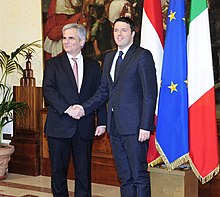Austria–Italy relations
 | |
Austria |
Italy |
|---|---|
Foreign relations exist between Austria and Italy. Austria has an embassy in Rome, a general consulate in Milan and 10 honorary consulates (in Bari, Bologna, Florence, Genoa, Naples, Palermo, Trieste, Turin, Venice and Verona). Italy has an embassy in Vienna, a consulate in Innsbruck, and 5 honorary consulates (in Graz, Klagenfurt, Bregenz, Linz and Salzburg). Both countries are full members of the Council of Europe and of the European Union.
History

Since the

Since the late Middle Ages, the Italians and Austrians have fought a number of wars, either as enemies or allies. Austria was allied with several Italian states during wars against the Ottoman Empire, e.g. with Tuscany, Mantua, Ferrara, Savoy and the Papal States in the war of 1593–1606, and with Venice in the wars of 1684–1699 and 1716–1718. Austria and the Republic of Venice warred against each other in the Uskok War of 1615–1618.
Since the 18th century,
Austrian rule in northern Italy created the conditions in which Italian
Despite entering into the
During World War I, Italy fought against Austria-Hungary despite their defensive alliance signed some decades earlier. By World War I's end, Italy emerged victorious and gained territories from Austria, incl. Trento, Brixen and Trieste, and border agreements were secured. During World War II, since 1943, Italian prisoners of war were among Allied POWs held in German POW camps operated in German-annexed Austria, such as Stalag XVII-A, Stalag XVII-B, Stalag XVIII-A, Stalag 317/XVIII-C, Stalag 398 and Oflag XVIII-A.[12]
Today

Both countries are full members of the
-
Palais Matternich in Vienna, seat of the Italian Embassy
-
Consulate General of Austria in Milan, Italy
-
TheMayor of Bolzano Renzo Caramaschi by the Bolzano Transit Campin 2019
See also
References
- ^ "Stile Barocco in Austria" (in Italian). Archived from the original on 2016-03-04. Retrieved 2015-08-06.
- ^ "War of the Spanish Succession". Britannica. Retrieved 5 February 2022.
- ^ "Quadruple Alliance". Britannica. Retrieved 5 February 2022.
- ^ "War of the Polish Succession". Britannica. Retrieved 5 February 2022.
- ^ "Treaty of Campo Formio". The Napoleon Series. Retrieved 5 February 2022.
- ^ "Le traité de paix de Presbourg, 26 décembre 1805". Napoleon.org (in French). Retrieved 5 February 2022.
- ISBN 978-0-911198-41-6.
- ^ Rothenburg 1976, p. 99.
- ^ Rothenburg 1976, p. 124-25.
- ^ Rothenburg 1976, p. 152.
- ^ Rothenburg 1976, p. 163.
- ISBN 978-0-253-06089-1.
- ^ "Italy big ally - Austria's Kickl (3) - English". ANSA.it. 5 June 2018.





